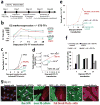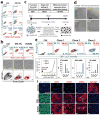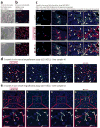Efficient direct reprogramming of mature amniotic cells into endothelial cells by ETS factors and TGFβ suppression
- PMID: 23084400
- PMCID: PMC3507451
- DOI: 10.1016/j.cell.2012.09.032
Efficient direct reprogramming of mature amniotic cells into endothelial cells by ETS factors and TGFβ suppression
Abstract
ETS transcription factors ETV2, FLI1, and ERG1 specify pluripotent stem cells into induced vascular endothelial cells (iVECs). However, iVECs are unstable and drift toward nonvascular cells. We show that human midgestation c-Kit(-) lineage-committed amniotic cells (ACs) can be reprogrammed into vascular endothelial cells (rAC-VECs) without transitioning through a pluripotent state. Transient ETV2 expression in ACs generates immature rAC-VECs, whereas coexpression with FLI1/ERG1 endows rAC-VECs with a vascular repertoire and morphology matching mature endothelial cells (ECs). Brief TGFβ-inhibition functionalizes VEGFR2 signaling, augmenting specification of ACs into rAC-VECs. Genome-wide transcriptional analyses showed that rAC-VECs are similar to adult ECs in which vascular-specific genes are expressed and nonvascular genes are silenced. Functionally, rAC-VECs form stable vasculature in Matrigel plugs and regenerating livers. Therefore, short-term ETV2 expression and TGFβ inhibition with constitutive ERG1/FLI1 coexpression reprogram mature ACs into durable rAC-VECs with clinical-scale expansion potential. Banking of HLA-typed rAC-VECs establishes a vascular inventory for treatment of diverse disorders.
Copyright © 2012 Elsevier Inc. All rights reserved.
Figures







Similar articles
-
Direct conversion of human amniotic cells into endothelial cells without transitioning through a pluripotent state.Nat Protoc. 2015 Dec;10(12):1975-85. doi: 10.1038/nprot.2015.126. Epub 2015 Nov 5. Nat Protoc. 2015. PMID: 26540589 Free PMC article.
-
Etv2- and Fli1-Induced Vascular Progenitor Cells Enhance Functional Recovery in Ischemic Vascular Disease Model-Brief Report.Arterioscler Thromb Vasc Biol. 2020 Apr;40(4):e105-e113. doi: 10.1161/ATVBAHA.119.313684. Epub 2020 Feb 20. Arterioscler Thromb Vasc Biol. 2020. PMID: 32075417
-
High-efficiency production of subculturable vascular endothelial cells from feeder-free human embryonic stem cells without cell-sorting technique.Cloning Stem Cells. 2009 Dec;11(4):509-22. doi: 10.1089/clo.2009.0023. Cloning Stem Cells. 2009. PMID: 20025522
-
Regulation of endothelial cell development by ETS transcription factors.Semin Cell Dev Biol. 2011 Dec;22(9):976-84. doi: 10.1016/j.semcdb.2011.09.009. Epub 2011 Sep 18. Semin Cell Dev Biol. 2011. PMID: 21945894 Free PMC article. Review.
-
Transplantation of Endothelial Cells to Mitigate Acute and Chronic Radiation Injury to Vital Organs.Radiat Res. 2016 Aug;186(2):196-202. doi: 10.1667/RR14461.1. Epub 2016 Jul 26. Radiat Res. 2016. PMID: 27459700 Free PMC article. Review.
Cited by
-
Human Cardiomyocytes Prior to Birth by Integration-Free Reprogramming of Amniotic Fluid Cells.Stem Cells Transl Med. 2016 Dec;5(12):1595-1606. doi: 10.5966/sctm.2016-0016. Epub 2016 Jul 27. Stem Cells Transl Med. 2016. PMID: 27465073 Free PMC article.
-
Transdifferentiation of Fibroblasts by Defined Factors.Cell Reprogram. 2015 Jun;17(3):151-9. doi: 10.1089/cell.2014.0089. Cell Reprogram. 2015. PMID: 26053515 Free PMC article. Review.
-
Generation of Endothelial Cells From Human Pluripotent Stem Cells.Arterioscler Thromb Vasc Biol. 2019 Jul;39(7):1317-1329. doi: 10.1161/ATVBAHA.119.312265. Epub 2019 May 9. Arterioscler Thromb Vasc Biol. 2019. PMID: 31242035 Free PMC article. Review.
-
Metastable Reprogramming State of Single Transcription Factor-Derived Induced Hepatocyte-Like Cells.Stem Cells Int. 2019 Apr 7;2019:6937257. doi: 10.1155/2019/6937257. eCollection 2019. Stem Cells Int. 2019. PMID: 31089332 Free PMC article.
-
In vivo reprogramming of pancreatic acinar cells to three islet endocrine subtypes.Elife. 2014 Jan 1;3:e01846. doi: 10.7554/eLife.01846. Elife. 2014. PMID: 24714494 Free PMC article.
References
-
- Bossolasco P, Montemurro T, Cova L, Zangrossi S, Calzarossa C, Buiatiotis S, Soligo D, Bosari S, Silani V, Deliliers GL, et al. Molecular and phenotypic characterization of human amniotic fluid cells and their differentiation potential. Cell Res. 2006;16:329–336. - PubMed
Publication types
MeSH terms
Substances
Grants and funding
LinkOut - more resources
Full Text Sources
Other Literature Sources
Molecular Biology Databases
Research Materials
Miscellaneous

